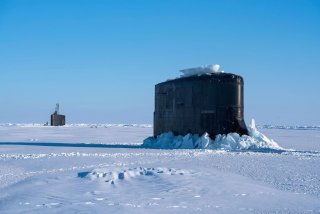Why American Subs Are Training to Fight Russia in the Arctic Circle
One might call it a Cold War.
Key point: With climate change thawing the Arctic and opening new waterways and resources, both Russia and America are rushing to secure their dominance in the area.
Navy fast-attack submarines have been firing torpedoes beneath the Arctic ice as part of large scale effort to speed up preparations for war in the region in response to growing tensions with Russia and the increasing pace of melting ice.
During a recent US-UK ICEX exercise in the Arctic, the Seawolf-class fast-attack submarine USS Connecticut and the Los Angeles-class fast-attack submarine USS Hartford each fired several training torpedos under the ice, a Navy statement said.
"The primary objective of this year's ICEX is to test new under-ice weapons systems and validate tactics for weapon employment," Ryan Dropek, Naval Undersea Warfare Center Division Newport, Rhode Island Weapons Test Director, said in a written Navy statement. "Once the divers recover these torpedoes, we can extract important data about how they perform and react in these conditions."
While training torpedoes have no warheads and carry small amounts of fuel, they are useful in assessing the weapon’s performance in Arctic conditions. Overall, the ICEX exercises is designed to test combat and weapons systems, sonar systems, communications and navigation systems in a challenging operational environment.
Recommended: The 5 Biggest Nuclear Bomb Tests (From All 6 Nuclear Powers).
Recommended: How Israel Takes U.S. Weapons and Makes Them Better.
Recommended: North Korea’s Most Lethal Weapon Isn’t Nukes.
“The unique acoustic undersea environment is further compounded by the presence of a contoured, reflective ice canopy when submerged,” a Navy statement said.
Several years ago, the Navy updated its 2009 Arctic Road Map which includes mission analysis and “fleet readiness” details for the Arctic environment. This included discussion of a need for more ice-breakers, a large-scale increase in deploying Navy ships to the Arctic and various research efforts to further ruggedize Navy ships for Arctic conditions.
For example, experts with the Office of Naval Research have been looking at warming ship hull coatings able to melt through ice as well as various techniques designed to enable weapons and sensors to function in an Arctic environment.
These efforts include technologies that allow weapons and sensors to better operate in an arctic environment and using special gear to “knock” ice off of the superstructure of a surface ship. This could also include working on technologies to build heating elements into the superstructure of the ship itself, Navy officials said.
The updated Arctic Road Map also includes discussion of search and rescue, maritime security, C4ISR, cooperation with the U.S. Coast Guard, strategic sealift and strategic deterrence, among other things. Updated Arctic Road Map that explains how increasing water temperatures and decreasing ice layers mean the service will need to increase the number of ships in the region over the next 20 years.
“The Arctic is warming twice as fast as the rest of the globe. While significant uncertainty exists in projections for Arctic ice extent, the current scientific consensus indicates the Arctic may experience nearly ice free summers sometime in the 2030’s,” the text of the 2009 Arctic Road Map states.
An assessment done by the Navy’s Task Force Climate Change several years ago determined that the rate of melting had increased since the time of the prior report. Therefore, part of the new, “updated” roadmap was to bring the most current scientific projections regarding the changing ice and water conditions in the Arctic.
Less ice in the Arctic means more open water, waterways and shipping routes in the region. More open water naturally leads to increased maritime transportation and greater competition for natural resources such as oil and gas mining.
As a result, Navy scientists have been using unmanned underwater autonomous robots, or drones, to examine what's called the marginal ice zone – the portion of frozen ocean's packed ice that meets open water, Navy experts have explained to Warrior.
Arctic Tensions With Russia
Russian President Vladimir Putin's aggressive stance in Ukraine has added to the urgency of Navy preparations for Arctic warfare and, not surprisingly, the Russian Navy also has plans to increase its presence in the region. More Arctic Ocean waterways mean quicker and more prevalent routes for Russian ships to North America.
Competition for strategic influence, resources, territory and geographical access are growing quickly in the Arctic region as countries accelerate efforts to capitalize on changing conditions and maximize advantage.
The largest existing Arctic shipping route, called the Northern Sea Route, largely parallels the Russian border with the Arctic. This route has seen a large increase in traffic in recent years, officials said.
The Russians operate numerous large “ice-breaker” ships designed to escort commercial vessels through ice-patches by breaking up and separating the ice. Ships wishing to pass through the Northern Sea Route are charged a fee by the Russians for the ice-breaking vessels they provide for safe passage.
This first appeared in Warrior Maven here in March 2018.
Image: Reuters

